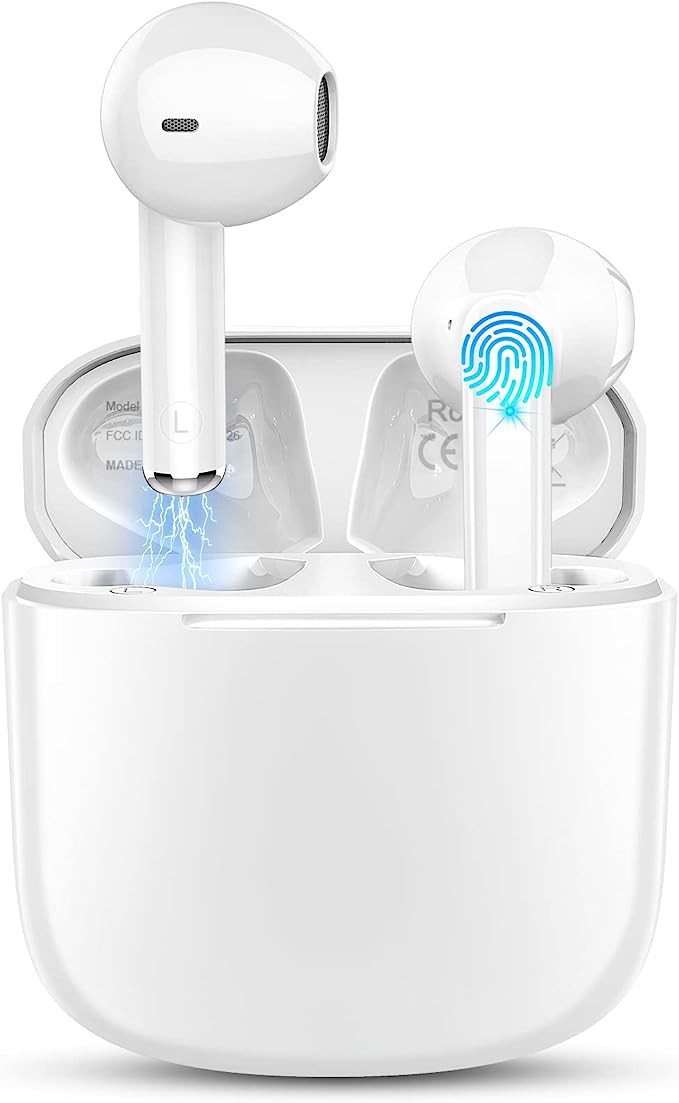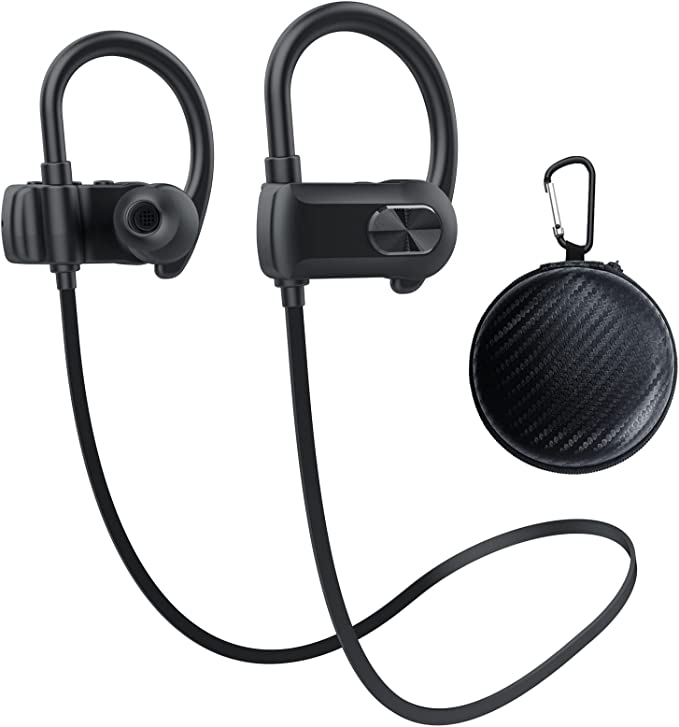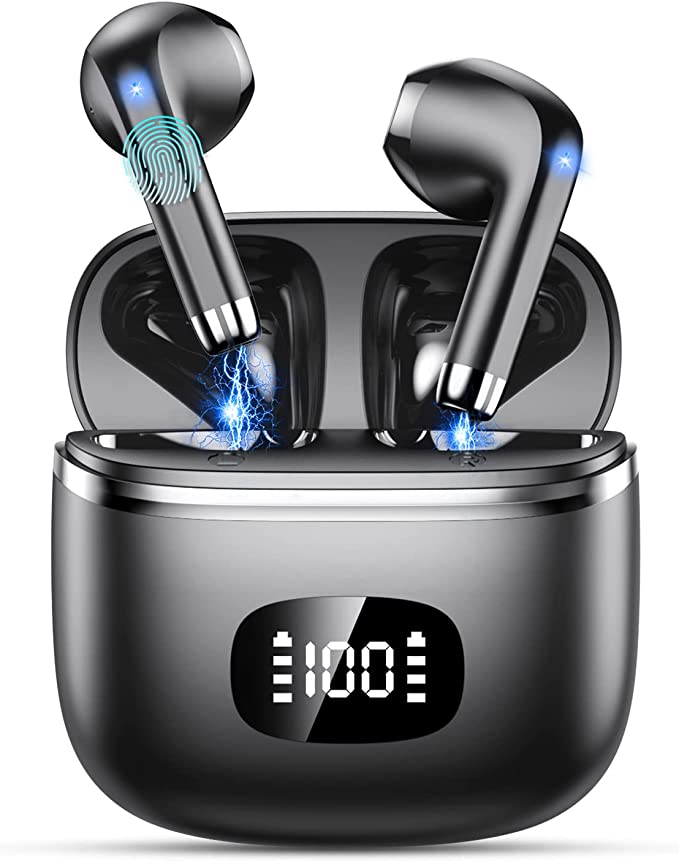In the bustling soundscape of modern life, our personal audio devices have become more than just accessories; they are intimate companions. They curate our private soundtracks, connect us to distant voices, and shield us with moments of focused calm amidst the daily din. The unassuming wireless earbud, so easily slipped into a pocket, is a testament to the marvels of miniaturized technology. It’s a tiny powerhouse of sophisticated engineering. Today, we’re not conducting a review, but rather embarking on an exploration, using the Drsaec MD016 Wireless Earbuds as our fascinating “specimen.” Let’s peel back the layers and discover the science that shapes what we hear and how we interact with our auditory world.

The Unseen Handshake: Decoding Bluetooth 5.3 and Seamless Connectivity
At the very foundation of any wireless audio experience lies the invisible handshake of its connection technology. The Drsaec MD016 earbuds, according to their specifications, are equipped with Bluetooth 5.3. Now, this isn’t just an incremental version number; it represents a significant step in the evolution of a technology that has untethered us for decades. Think of it as upgrading from a winding, sometimes congested, country road to a smoother, more efficient multi-lane expressway for your audio data.
Bluetooth 5.3 brings to the table enhanced stability, which means fewer frustrating dropouts or stutters, even when you’re navigating a crowded café wirelessly buzzing with a multitude of devices. It’s also designed for greater power efficiency. This is crucial for small devices like earbuds, as it directly translates to longer listening times between charges – a small but significant victory for anyone who has had their music die premios_playoffs_finalesly. The Drsaec MD016’s product description mentions a “twin Bluetooth 5.3 chip.” While the specific architecture of such a setup can vary, a dual-chip design can theoretically bolster this stability further, potentially by dedicating resources to different aspects of the connection or by providing redundancy, ensuring a more robust link to your smartphone or tablet.
This robust connection is the unsung hero of good wireless audio. It’s the foundation upon which clear music and intelligible calls are built. The claim of supporting “24bit 420kHz high-definition sound quality for music,” while ambitious for any Bluetooth connection due to bandwidth limitations and codec dependencies (common codecs include SBC, AAC, and various aptX versions, though not specified for this product), fundamentally relies on the integrity of this wireless link to deliver as much audio information as possible. The pairing process, too, benefits from these advancements, with the MD016 aiming for that almost magical experience of taking the earbuds from their case and having them automatically connect to each other, then seamlessly pair with your phone in a single step. It’s this kind of intuitive, frictionless interaction that transforms a piece of technology from a mere tool into a delightful extension of our senses.

Clarity Amidst the Chaos: The Four-Microphone ENC Advantage
Imagine yourself on a busy city street, the cacophony of traffic, distant sirens, and chattering pedestrians forming a wall of sound. Or perhaps you’re in a vibrant open-plan office, where a dozen conversations blend into a distracting hum. In these sonic battlegrounds of daily life, attempting to hold a clear phone conversation can be a frustrating endeavor. This is where the Drsaec MD016’s specified four-microphone array working with Environmental Noise Cancellation (ENC) technology steps into the spotlight.
It’s important to distinguish ENC from its perhaps more commonly known cousin, Active Noise Cancellation (ANC). While ANC primarily focuses on creating a quieter listening experience for you by actively neutralizing external sounds before they reach your ears, ENC is predominantly about ensuring your voice is heard clearly by the person on the other end of the call. Think of ENC as your voice’s personal bodyguard, adept at navigating a noisy crowd and ensuring your words are delivered with precision.
The MD016 earbuds reportedly feature four microphones. This quartet doesn’t just passively pick up sound; they work in concert. Through a sophisticated process, often involving beamforming techniques (though not explicitly detailed for this product, it’s a common approach), these microphones can create a focused listening zone directed towards your mouth. Some microphones will be optimized to capture your voice, while others simultaneously sample the ambient noise. Then, Digital Signal Processing (DSP) – the brains of the operation – intelligently analyzes these inputs. It works to distinguish the unique frequencies and patterns of your speech from the surrounding noise, effectively filtering out or significantly reducing those unwanted sounds. The product description claims this system can eliminate external noise by “up to 28dB” and deliver “up to 3 times clearer calls than other truly wireless earbud[s].” While such figures are best understood in context and can vary based on the specific noise environment, the underlying principle is sound: by actively reducing the noise that gets transmitted along with your voice, your caller hears more of you and less of the world around you. In an era of increasing remote work and on-the-go communication, this focus on call clarity is rapidly becoming as crucial as music fidelity itself.

The Heartbeat of Your Music: Understanding the 13mm Pu+Biological Composite Drivers
If Bluetooth and ENC form the communication backbone, then the audio drivers are the very soul of the earbuds, the tiny engines that transform electrical signals back into the rich tapestry of sound that can move us, energize us, or calm us. The Drsaec MD016 earbuds are said to house 13mm Pu+Biological composite drivers.
Let’s break that down. The “13mm” refers to the diameter of the driver. In the world of earbud acoustics, this is a relatively generous size. Generally, a larger driver diaphragm has the potential to move more air, which can be particularly beneficial for reproducing lower frequencies, giving bass notes a more palpable presence and fullness.
The material of this diaphragm is where things get particularly interesting. “Pu” likely refers to Polyurethane, a versatile polymer often favored in speaker design for its excellent damping characteristics and ability to remain flexible yet durable. This flexibility allows the diaphragm to vibrate accurately, producing sound waves, while the damping helps to control unwanted resonances that could color the sound. The “Biological composite” part suggests that this polyurethane is augmented with or layered with materials derived from natural sources, such as bio-cellulose fibers. These bio-materials are increasingly prized in audio engineering for their unique combination of lightness and rigidity. A diaphragm that is both light and stiff can respond more quickly and precisely to the audio signal, leading to clearer sound, reduced distortion, and better reproduction of fine details, especially in the midrange and treble frequencies.
The aim of such a composite driver, as described for the MD016, is to achieve a “Hi-Fi Stereo Sound” characterized by “extra bass [43%+] , mellow vocal and surprising treble.” The polyurethane might contribute to the depth and impact of the bass, while the biological composite helps to ensure that vocals remain clear and natural (“mellow”) and that higher frequencies sparkle with detail (“surprising treble”). It’s this careful balancing act, this science of material selection and acoustic tuning, that strives to reproduce music vividly and authentically. The previously mentioned “24bit 420kHz” sound quality claim, in the context of the driver, would refer to the driver’s potential to accurately reproduce a high-resolution signal if such a signal could be perfectly delivered and decoded. The driver’s role is to be as faithful as possible to the source it’s given.

Ready for Anything: The Practical Science of IP7 Waterproofing
Life is gloriously unpredictable, and our gadgets increasingly need to keep pace with our varied activities, whether that’s a sweat-drenched workout, a jog in a sudden rain shower, or even an accidental, heart-stopping fumble near water. The Drsaec MD016 earbuds and their charging case are specified with an IP7 waterproof rating.
Let’s decode that “IP7.” The “IP” stands for Ingress Protection, a standard defined by the International Electrotechnical Commission (IEC). The first digit (which would be ‘X’ if not tested for solid particle protection, as is common for earbuds primarily concerned with liquid) relates to protection against solids, and the second digit relates to protection against liquids. The ‘7’ in IP7 is quite specific: it signifies that the device is protected against the effects of temporary immersion in water. The standard test conditions usually involve submersion in up to 1 meter of water for up to 30 minutes.
Achieving this level of water resistance in such a compact device involves meticulous engineering. It often includes a combination of precision-fit casings, O-rings or rubber seals at vulnerable points (like charging contacts or seams), and sometimes the application of hydrophobic nano-coatings on internal components. These ultra-thin coatings work at a molecular level to repel water, preventing it from adhering to and damaging sensitive electronics. For the user, an IP7 rating on both the earbuds and the case translates to significant peace of mind. It means your music doesn’t have to stop for a bit of rain, and your investment is better protected against the everyday encounters with moisture that can spell doom for less resilient electronics. This isn’t just a feature; it’s technology adapting to the fluid reality of our lives.
The Freedom of Unplugged: Battery Life and the Convenience of USB-C Fast Charging
The very promise of “wireless” earbuds hinges on their ability to provide a sustained, untethered experience. This is where battery technology becomes paramount. The Drsaec MD016 earbuds are powered by Lithium Polymer batteries, a common choice for modern portable electronics due to their high energy density relative to their weight and their ability to be molded into the compact shapes required for in-ear devices.
According to the specifications, these earbuds offer 6-7 hours of listening time on a single charge. While actual playtime can vary based on factors like listening volume, the complexity of the audio being played, and even the ambient temperature, this figure provides a solid baseline for extended listening sessions. The accompanying charging case then acts as a portable power bank, capable of recharging the earbuds an additional “3-4 times,” extending the total listening an “up to 35 hours” before the case itself needs replenishing. This kind of endurance means you can often go a full week of typical daily use without needing to hunt for a power outlet.
When it is time to recharge the case, the inclusion of a USB-C port is a welcome nod to modern convenience. USB-C offers a reversible connector (no more fumbling to plug it in the right way) and generally supports higher power delivery for faster charging. The MD016 earbuds leverage this with a fast-charging capability: a mere 10-minute charge is stated to provide up to 1 hour of playtime. This quick-boost feature is incredibly practical for those moments when you realize your earbuds are low on power just as you’re about to head out the door. It’s these advancements in battery chemistry and charging protocols that truly underpin the “wireless freedom” we’ve come to expect.

Ergonomics and Intuition: The Art of Comfortable Design and Effortless Control
Beyond the complex interplay of internal electronics, the physical design of an earbud is critical to the overall user experience. Technology, after all, must interface comfortably with the human body. The Drsaec MD016 earbuds are described as weighing a mere 4 grams each, featuring an “ultra lightweight contoured design.” This focus on ergonomics is vital. A well-designed earbud should conform naturally to the unique shapes and curves of the human ear, distributing its minimal weight evenly to provide a secure, stable fit without creating undue pressure points. The goal is long-term comfort, allowing you to wear them for hours – whether for an extended work call, a long-haul flight, or an immersive music session – almost forgetting they’re there.
Interaction with the earbuds is managed via intelligent touch controls. These are typically implemented using capacitive sensors embedded just beneath the earbud’s surface. These sensors detect the subtle changes in electrical capacitance caused by the touch of your fingertip. A tap, a double-tap, or a press-and-hold can be programmed to trigger various functions: playing or pausing music, skipping tracks, adjusting volume, answering or rejecting calls, or even activating your phone’s native voice assistant (like Siri or Google Assistant). This allows for a more intuitive and discreet way to manage your audio and communication without constantly needing to reach for your smartphone, further enhancing that feeling of seamless integration. The best technology often strives to become an invisible extension of our intent, and thoughtful ergonomic design paired with intuitive controls are key to achieving that.
The Harmonious Ensemble: How These Technologies Sing Together
It’s important to remember that the features we’ve explored – the steadfast Bluetooth 5.3 connection, the voice-isolating prowess of the 4-mic ENC system, the nuanced sound from the 13mm composite drivers, the resilience of IP7 waterproofing, the enduring battery, and the intuitive touch controls – don’t operate in isolation. In a well-engineered product like the Drsaec MD016 aims to be, these technologies are designed to work in synergy, a harmonious ensemble where each component plays its part to create a cohesive and satisfying overall user experience.
A stable connection ensures that the detailed sound produced by the drivers reaches your ears without corruption. Clear call technology allows the sophisticated audio reproduction to be used for equally important voice communication. Durable, waterproof construction means you can enjoy these audio experiences in a wider range of environments without anxiety. And long battery life coupled with comfortable, intuitive design ensures that you can access all these benefits for extended periods, effortlessly. It’s this interplay, this thoughtful integration, that elevates a collection of specifications into a genuinely useful and enjoyable everyday tool.
Conclusion: The Ever-Evolving Soundtrack of Our Lives
The Drsaec MD016 wireless earbuds, as we’ve explored through the lens of their described technologies, offer a compelling glimpse into the sophisticated science and engineering that underpin even our most accessible consumer electronics. From the invisible dance of radio waves in Bluetooth 5.3 to the meticulous material science of its audio drivers, each element is a piece of a larger puzzle aimed at enriching our auditory experiences.
This journey isn’t just about one product; it’s a reflection of a broader trend. The quest for better sound, clearer communication, and more resilient, intuitive, and seamlessly integrated personal audio devices is relentless. As technology continues to evolve, the soundtrack of our lives will undoubtedly become richer, more immersive, and more effortlessly woven into the fabric of our daily routines. Perhaps the next time you pop in your earbuds, you’ll pause for a moment to appreciate the symphony of science resting so lightly in your ears, a small but potent reminder of human ingenuity.




